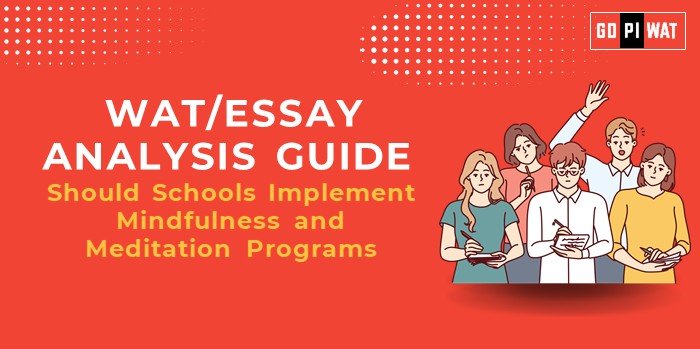📘 Should Schools Implement Mindfulness and Meditation Programs?
🌟 Understanding the Topic’s Importance
Mindfulness in schools addresses the growing need for emotional well-being, directly aligning with broader goals in education and workforce readiness. Incorporating mindfulness can help students manage stress, improve focus, and build resilience—key skills for personal and academic success.
📝 Effective Planning and Writing
- Time Allocation:
- Planning: 5 minutes
- Writing: 20 minutes
- Review: 5 minutes
- Preparation Tips:
- Gather recent statistics on mental health and mindfulness impact in schools.
- Understand cultural sensitivities and diverse perspectives on mindfulness practices.
📖 Introduction Techniques for Essays
Contrast Approach: “While education systems prioritize grades, they often overlook mental well-being. Mindfulness bridges this critical gap by enhancing emotional resilience and academic focus.”
Solution-Based Start: “To tackle rising student stress levels, schools worldwide are adopting mindfulness programs—a proven tool for mental clarity and focus.”
📚 Structuring the Essay Body
🏆 Achievements
- 📉 Reduced Anxiety: Studies show mindfulness programs reduce student anxiety by up to 15%.
- 📈 Improved Focus: Participants demonstrate higher academic performance and better attention spans.
- 🌍 Global Success: Countries like Finland have implemented mindfulness in schools with measurable positive outcomes.
⚠️ Challenges
- 🌐 Implementation Issues: Limited budgets and teacher training create barriers to adopting mindfulness programs.
- 📖 Cultural Resistance: Some communities associate mindfulness practices with specific religions, leading to skepticism.
- 👩🏫 Training Gaps: Teachers often lack the skills or resources to lead mindfulness sessions effectively.
🌏 Future Outlook
- 💻 Scalable Solutions: Introduce online mindfulness modules to reach more students cost-effectively.
- 🤝 NGO Partnerships: Collaborate with organizations to provide resources and training for teachers.
- 📜 Policy Support: Advocate for mindfulness programs in national education policies to standardize implementation.
🎯 Concluding Effectively
Balanced Perspective Conclusion: “Mindfulness programs hold immense promise but require strategic implementation and cultural adaptability for success.”
Global Comparison Conclusion: “By learning from countries like Finland, schools can adopt inclusive and effective mindfulness practices.”
✍️ Sample Short Essays
📖 Balanced Perspective
“Mindfulness programs in schools can improve focus and well-being, but cultural resistance and budget constraints pose challenges. Strategic adaptation is essential for success.”
💡 Solution-Oriented
“Mindfulness offers a low-cost, high-impact solution to student stress. Proper teacher training and secular approaches can ensure its broader acceptance.”
🌍 Global Comparison
“Countries like Finland demonstrate the success of mindfulness programs in schools. India could follow suit by addressing cultural concerns and training gaps.”


